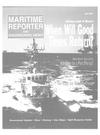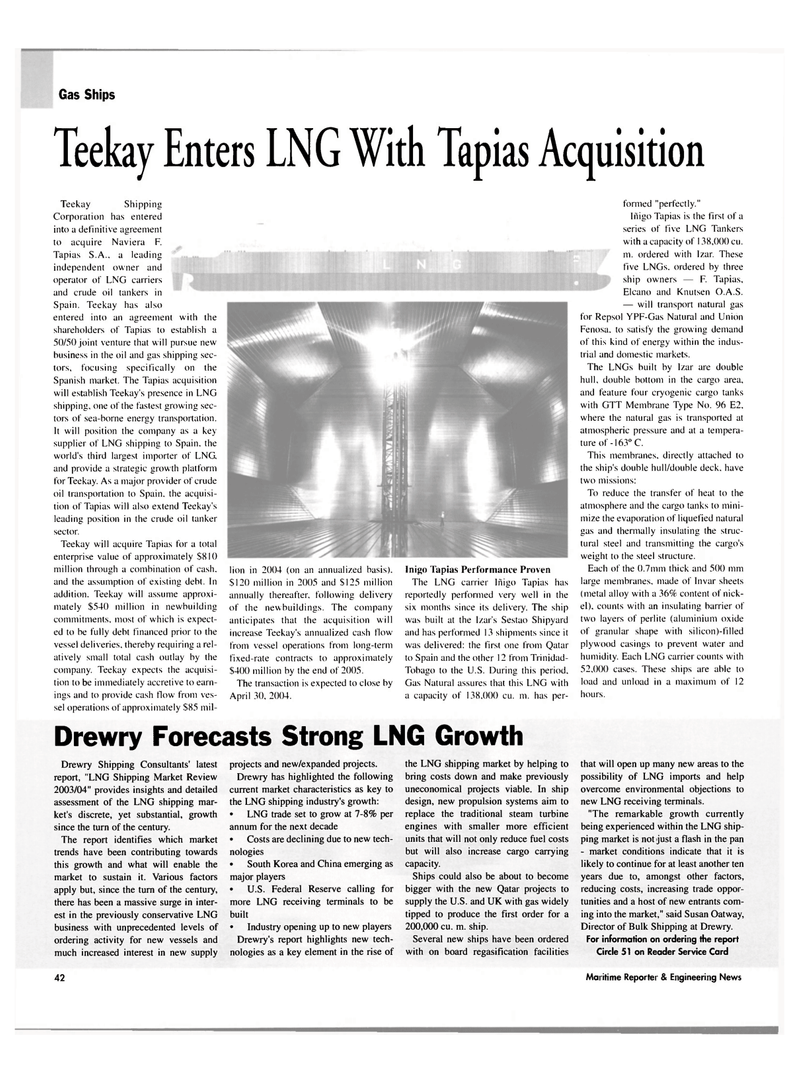
Page 44: of Maritime Reporter Magazine (April 2004)
Offshore Technology Yearbook
Read this page in Pdf, Flash or Html5 edition of April 2004 Maritime Reporter Magazine
Gas Ships
Teekay Enters LNG With Tapias Acquisition
Teekay Shipping
Corporation has entered into a definitive agreement to acquire Naviera F.
Tapias S.A.. a leading independent owner and operator of LNG carriers and crude oil tankers in
Spain. Teekay has also entered into an agreement with the shareholders of Tapias to establish a 50/50 joint venture that will pursue new business in the oil and gas shipping sec- tors, focusing specifically on the
Spanish market. The Tapias acquisition will establish Teekay's presence in LNG shipping, one of the fastest growing sec- tors of sea-borne energy transportation.
It will position the company as a key supplier of LNG shipping to Spain, the world's third largest importer of LNG and provide a strategic growth platform for Teekay. As a major provider of crude oil transportation to Spain, the acquisi- tion of Tapias will also extend Teekay's leading position in the crude oil tanker sector.
Teekay will acquire Tapias for a total enterprise value of approximately $810 million through a combination of cash, and the assumption of existing debt. In addition. Teekay will assume approxi- mately $540 million in newbuilding commitments, most of which is expect- ed to be fully debt financed prior to the vessel deliveries, thereby requiring a rel- atively small total cash outlay by the company. Teekay expects the acquisi- tion to be immediately accretive to earn- ings and to provide cash flow from ves- sel operations of approximately $85 mil- lion in 2004 (on an annualized basis). $120 million in 2005 and $125 million annually thereafter, following delivery of the newbuildings. The company anticipates that the acquisition will increase Teekay's annualized cash flow from vessel operations from long-term fixed-rate contracts to approximately $400 million by the end of 2005.
The transaction is expected to close by
April 30, 2004.
Inigo Tapias Performance Proven
The LNG carrier Ifiigo Tapias has reportedly performed very well in the six months since its delivery. The ship was built at the Izar's Sestao Shipyard and has performed 13 shipments since it was delivered: the first one from Qatar to Spain and the other 12 from Trinidad-
Tobago to the U.S. During this period.
Gas Natural assures that this LNG with a capacity of 138.000 cu. m. has per-
Drewry Forecasts Strong LNG Growth
Drewry Shipping Consultants' latest report, "LNG Shipping Market Review 2003/04" provides insights and detailed assessment of the LNG shipping mar- ket's discrete, yet substantial, growth since the turn of the century.
The report identifies which market trends have been contributing towards this growth and what will enable the market to sustain it. Various factors apply but, since the turn of the century, there has been a massive surge in inter- est in the previously conservative LNG business with unprecedented levels of ordering activity for new vessels and much increased interest in new supply projects and new/expanded projects.
Drewry has highlighted the following current market characteristics as key to the LNG shipping industry's growth: • LNG trade set to grow at 7-8% per annum for the next decade • Costs are declining due to new tech- nologies • South Korea and China emerging as major players • U.S. Federal Reserve calling for more LNG receiving terminals to be built • Industry opening up to new players
Drewry's report highlights new tech- nologies as a key element in the rise of formed "perfectly."
Ifiigo Tapias is the first of a series of five LNG Tankers with a capacity of 138,000 cu. m. ordered with Izar. These five LNGs. ordered by three ship owners — F. Tapias,
Elcano and Knutsen O.A.S. — will transport natural gas for Repsol YPF-Gas Natural and Union
Fenosa, to satisfy the growing demand of this kind of energy within the indus- trial and domestic markets.
The LNGs built by Izar are double hull, double bottom in the cargo area, and feature four cryogenic cargo tanks with GTT Membrane Type No. 96 E2, where the natural gas is transported at atmospheric pressure and at a tempera- ture of -163° C.
This membranes, directly attached to the ship's double hull/double deck, have two missions:
To reduce the transfer of heat to the atmosphere and the cargo tanks to mini- mize the evaporation of liquefied natural gas and thermally insulating the struc- tural steel and transmitting the cargo's weight to the steel structure.
Each of the 0.7mm thick and 500 mm large membranes, made of Invar sheets (metal alloy with a 36% content of nick- el), counts with an insulating barrier of two layers of perlite (aluminium oxide of granular shape with silicon)-filled plywood casings to prevent water and humidity. Each LNG carrier counts with 52,000 cases. These ships are able to load and unload in a maximum of 12 hours. the LNG shipping market by helping to bring costs down and make previously uneconomical projects viable. In ship design, new propulsion systems aim to replace the traditional steam turbine engines with smaller more efficient units that will not only reduce fuel costs but will also increase cargo carrying capacity.
Ships could also be about to become bigger with the new Qatar projects to supply the U.S. and UK with gas widely tipped to produce the first order for a 200,000 cu. m. ship.
Several new ships have been ordered with on board regasification facilities that will open up many new areas to the possibility of LNG imports and help overcome environmental objections to new LNG receiving terminals. "The remarkable growth currently being experienced within the LNG ship- ping market is not just a flash in the pan - market conditions indicate that it is likely to continue for at least another ten years due to, amongst other factors, reducing costs, increasing trade oppor- tunities and a host of new entrants com- ing into the market," said Susan Oatway,
Director of Bulk Shipping at Drewry.
For information on ordering the report
Circle 51 on Reader Service Card 42 Maritime Reporter & Engineering News

 43
43

 45
45
